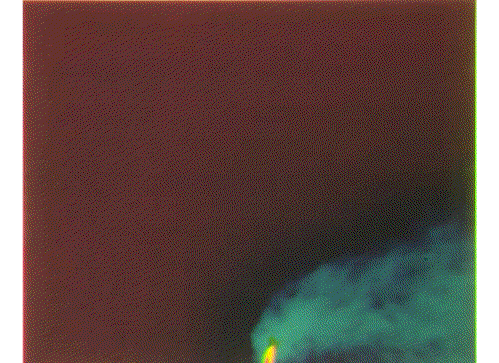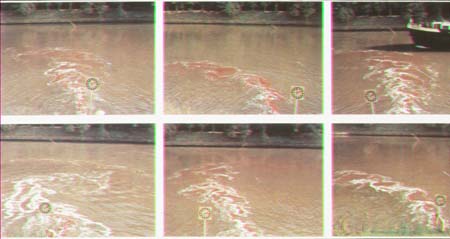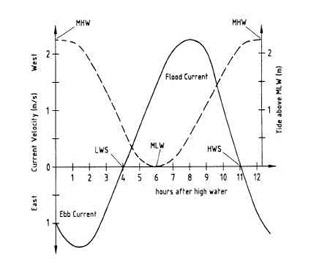When predictions are desired in an unsteady ambient flow field, information on the tidal cycle must be supplied.
In general, estuaries or coastal waters can exhibit considerable complexity
with variations in both velocity magnitude, direction and water depth.
The image on the right shows a plume advected by a tidally influenced ambient flow. Minimum dilutions generally occur
shortly after slack tide, which historic plume material remaining from the previous tidal cycle is re-entrained, reducing the available dilution.


Unsteady Ambient Currents |
|
|
|
A surface discharge in a tidal ambient tidal velocity fied. (Source Unknown)
|
Specification of Tidal Ambient Current Data
The example image on the right shows the time history of tidal velocities and tidal height for a mean tidal cycle at some site in Long Island Sound.
The tidal velocity changes its direction twice during the tidal cycle at times called slack tide.
One of these times occurs near, but is not necessarily coincident with, the time MLW and is referred to as Low Water Slack (LWS).
CORMIX needs some information on the ambient design conditions relative to any of the two slack tides. |
Example of tidal cycle, showing stage and velocity as a function of time after Mean High Water (MHW).
|
|
The rate reversal (time gradient of the tidal velocity) near these slack tides is of considerable importance for the concentration
build-up in the transient discharge plume.
|

A laboratory study of surface buoyant jet mixing in a unsteady tidal environment. Ambient velocity ranges from 0.2m/s left to right ,
slack, then 0.2 m/s right to left. In tidal mode, CORMIX gives estimates of reduced dilution due to tidal re-entrainment.
Minimum initial dilution generally occurs shortly after slack tide, when re-entrainment of the plume from the previous tidal cycle occurs.
Laser Induced Flourescent (LIF) images courtesy of J. Nash, DeFrees Hydraulics Laboratory, Cornell University.
|

